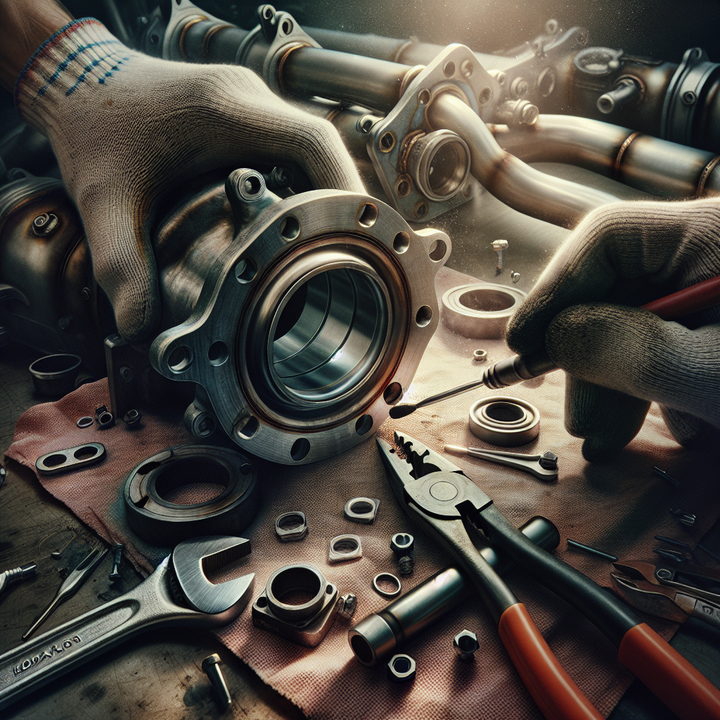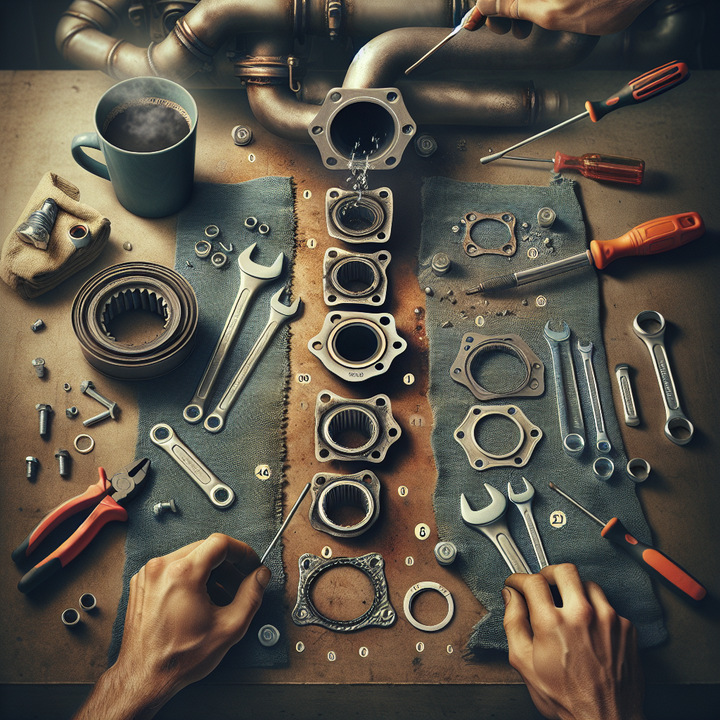


An exhaust flange leak is a common issue that can occur in vehicles, causing excessive noise, reduced engine performance, and potential safety hazards. The exhaust flange is the connection point where the exhaust pipe meets the catalytic converter, muffler, or other exhaust components. Over time, these flanges can corrode, crack, or become damaged, leading to leaks. Fixing an exhaust flange leak is a crucial maintenance task that can be performed as a DIY project, saving you money on costly repair bills from mechanics.

Before we dive into the repair process, let's take a moment to understand the exhaust system and its components. The exhaust system is responsible for expelling the harmful gases produced during the combustion process in your vehicle's engine. It consists of several interconnected parts, as shown in the table below:
| Component | Description |
|---|---|
| Exhaust Manifold | Collects exhaust gases from the engine cylinders |
| Catalytic Converter | Reduces harmful emissions by converting them into less harmful substances |
| Resonator | Helps reduce exhaust noise and vibrations |
| Muffler | Further reduces exhaust noise and emissions |
| Tailpipe | Expels the exhaust gases from the vehicle |
These components are connected using flanges and gaskets, which create a tight seal to prevent exhaust gases from escaping. Over time, however, these seals can deteriorate due to various factors, leading to leaks.
There are several reasons why an exhaust flange leak might occur:
Corrosion and Rust: The extreme heat and exposure to road elements can cause corrosion and deterioration of the gaskets and flanges over time. This is especially common in areas with harsh weather conditions or where road salt is used during winter. Rust can weaken the metal components, causing them to crack or break, leading to leaks.
Damaged or Worn-out Gaskets: The gaskets between the flanges are designed to seal the connection, but they can degrade and fail due to heat and vibration. As the gaskets wear out, they lose their ability to create a tight seal, allowing exhaust gases to escape. Gaskets are typically made of materials like asbestos, graphite, or metal, which can break down over time due to the high temperatures and vibrations in the exhaust system.
Physical Impact or Improper Installation: If the exhaust system has been subjected to physical impact, such as hitting a curb or a pothole, it can cause misalignment or damage to the flanges, leading to leaks. Improper installation or tightening of the components can also contribute to this issue. Even a slight misalignment can cause stress on the gaskets and flanges, leading to premature failure and leaks.
Normal Wear and Tear: Over time, the constant exposure to high temperatures and vibrations can cause holes or cracks to develop in the exhaust pipes, mufflers, or other components, resulting in leaks. The extreme conditions that the exhaust system operates under can take a toll on even the most durable materials, leading to eventual failure.
Before attempting any repairs, it's crucial to accurately diagnose the source of the leak. Here are some steps I typically follow:
I start by visually inspecting the entire exhaust system, paying close attention to the flanges, gaskets, and welded joints. Any signs of damage, holes, or soot buildup around these areas can indicate a leak. Here are some common visual cues to look for:
| Visual Cue | Potential Issue |
|---|---|
| Rust or corrosion | Weakened metal components |
| Soot buildup | Exhaust leak |
| Damaged or cracked components | Holes or cracks allowing leaks |
| Misaligned components | Stress on gaskets and flanges |
While the engine is running, I listen carefully for unusual noises like hissing, tapping, or rattling sounds, which can be indicators of an exhaust leak. These sounds can help pinpoint the general location of the leak.
I use a soap and water solution to check for bubbles forming around suspected leak areas when the engine is running. The presence of bubbles indicates escaping exhaust gases. This test can help confirm the exact location of the leak.
In some cases, I may pressurize the exhaust system using a vacuum cleaner or leaf blower. By feeling for air escaping, I can pinpoint the exact location of the leak. This method is particularly useful for hard-to-reach or hidden areas of the exhaust system.
Once the leak has been identified, it's time to start the repair process. The specific steps will depend on the severity and location of the leak, but here are some common repair procedures:
Gasket Replacement: For minor leaks at flanges, replacing the gasket with a new one and ensuring proper alignment and tightening of the bolts or clamps is often sufficient. It's essential to clean the mating surfaces thoroughly before installing the new gasket.
To replace a gasket, follow these steps:
Allow the exhaust system to cool completely.
Loosen and remove the bolts or clamps holding the flanges together.
Carefully separate the flanges and remove the old gasket.
Clean the mating surfaces with a wire brush or emery cloth to remove any debris or corrosion.
Install the new gasket, ensuring proper alignment.
Reassemble the flanges and tighten the bolts or clamps to the specified torque.
Flange Repair or Replacement: If the flanges themselves are damaged or corroded, you may need to replace the affected exhaust components or use an exhaust repair clamp or sleeve to bridge the gap. In some cases, a high-temperature exhaust sealant or putty can be used to seal any remaining gaps or pinholes.
Repairing or replacing flanges may involve:
Cutting out the damaged section and welding in a new flange
Using an exhaust repair clamp or sleeve to cover the damaged area
Applying a high-temperature sealant or putty to fill gaps or pinholes
Component Replacement: For larger holes or cracks, you may need to cut out the damaged section and replace it with a new exhaust pipe or component. This can be a more involved process and may require welding or specialized tools.
Replacing exhaust components typically involves:
Cutting out the damaged section using a reciprocating saw or exhaust pipe cutter
Welding or clamping in the new component, ensuring proper alignment and sealing
Replacing any necessary gaskets or hangers
Safety Precautions: Always follow proper safety precautions when working on the exhaust system. Allow the components to cool completely before attempting any repairs, and ensure adequate ventilation to avoid exposure to harmful exhaust gases. Wear appropriate protective gear, such as gloves and safety glasses.
While repairing an exhaust flange leak is essential, it's also crucial to take steps to prevent future issues. Here are some tips:

Regular Inspections and Maintenance: Regularly inspecting and maintaining the exhaust system can help identify potential problems before they become major issues. This includes checking for leaks, corrosion, and damage during routine maintenance or service appointments.
Careful Driving: Avoid driving over large bumps or obstacles that could potentially damage the exhaust components. Be mindful of your vehicle's clearance and take caution when navigating rough terrain or parking lots.
Upgrade to Corrosion-Resistant Materials: Consider upgrading to a stainless steel or aluminized exhaust system, which is more resistant to corrosion and rust. While more expensive initially, these systems can save you money in the long run by reducing the need for frequent repairs.
Proper Installation and Alignment: If you're replacing exhaust components or having repairs done, ensure that the installation is done correctly and that all components are properly aligned. This can help prevent future leaks and premature wear.
Protect from Road Elements: In areas where road salt is used during winter, consider applying a protective coating or sealant to the exhaust system to help prevent corrosion.
The cost of repairing an exhaust flange leak can vary depending on the extent of the damage and the specific components that need to be replaced. Here are some general cost estimates:
| Repair | Cost Range |
|---|---|
| Gasket Replacement | $20 - $100 for the gasket and labor |
| Exhaust Pipe or Muffler Replacement | $100 - $500 for parts and labor |
| Exhaust Manifold or Catalytic Converter Replacement | $300 - $1,000 or more, depending on the vehicle and parts needed |
| Professional Exhaust Repair or Welding | $100 - $500 or more, depending on the complexity of the job |
It's important to address exhaust leaks promptly, as they can lead to further damage, decreased fuel efficiency, and potential safety hazards if exhaust gases enter the cabin. While the cost of repairs may seem daunting, regular maintenance and timely repairs can help prevent more costly repairs down the line.
Fixing an exhaust flange leak may seem like a daunting task, but with the right knowledge and tools, it's a repair that can be tackled by experienced mechanics or DIY enthusiasts. By following the steps outlined in this article, you can accurately diagnose the issue, perform the necessary repairs, and take preventive measures to ensure the longevity of your vehicle's exhaust system.
Remember, addressing exhaust leaks promptly is crucial not only for the performance and efficiency of your vehicle but also for your safety and the safety of those around you. If you're ever unsure or uncomfortable with the repair process, don't hesitate to seek professional assistance from a qualified mechanic.
Safe and happy motoring!
Exhaust flange leaks are commonly caused by corrosion, damaged or worn-out gaskets, physical impact, and normal wear and tear over time.
Look for signs of soot buildup, damaged components, misaligned parts, and rust or corrosion around flanges, gaskets, and welded joints.
It involves spraying a soap and water solution around suspected leak areas while the engine is running - any leaks will cause bubbles to form.
Clean the mating surfaces, install the new gasket ensuring proper alignment, reassemble the flanges, and tighten the bolts or clamps to the specified torque.
Replace components if there are large holes, cracks, or extensive corrosion that cannot be repaired with a sealant or patch.
Allow the exhaust system to cool completely, wear protective gear, ensure proper ventilation, and use jack stands when working under the vehicle.
Perform regular inspections, drive carefully to avoid impacts, consider upgrading to corrosion-resistant materials, ensure proper installation and alignment, and protect from road elements.
Costs can range from $20-$100 for gasket replacement to $300-$1,000 or more for replacing major components like manifolds or catalytic converters.
RTV sealant is generally not recommended for exhaust repairs as it may not withstand the high temperatures and vibrations.
A flex pipe allows for movement and flexibility in the exhaust system to prevent cracking or damage from vibrations and engine movement.

Sarah isn't your average gearhead. With a double major in Mechanical Engineering and Automotive Technology, she dived straight into the world of car repair. After 15 years of turning wrenches at dealerships and independent shops, Sarah joined MICDOT to share her expertise and passion for making cars run like new. Her in-depth knowledge and knack for explaining complex issues in simple terms make her a valuable asset to our team.








